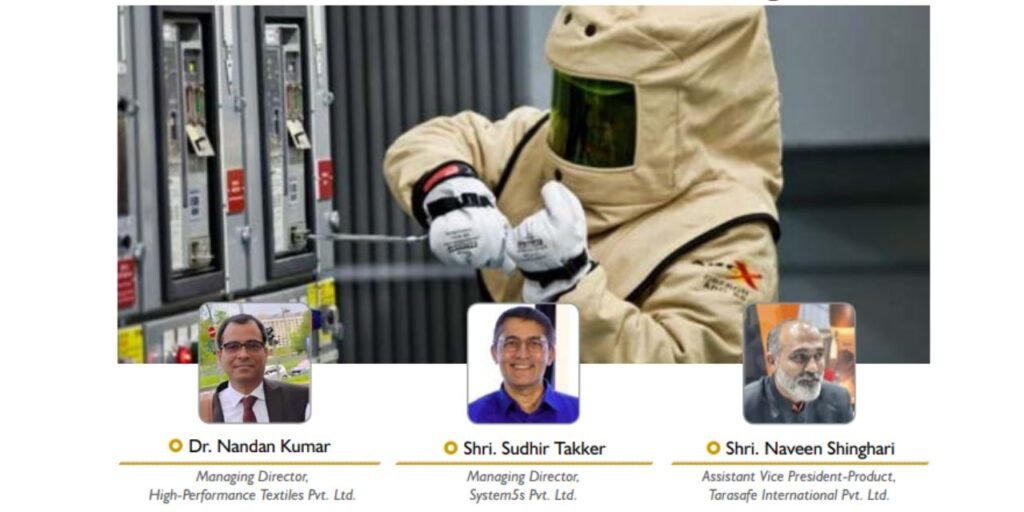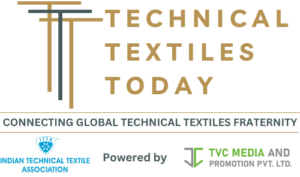
Abstract: The cover story on electric arc protective clothing provides an in-depth look at the current landscape, challenges, and advancements in this essential segment of workplace safety. The market for electric arc clothing currently stands at approximately Rs 100 crore annually, though this figure could reach
around Rs 200 crore since the demand for arc-rated protective gear is surging as more companies prioritize
personal protective equipment (PPE) for their workforce. From 2019 to 2023, the electric arc clothing market
has seen a compound annual growth rate (CAGR) of approximately 4-6%. This feature includes insights
from industry leaders like High-Performance Textiles Pvt. Ltd., System5s Pvt. Ltd., and Tarasafe International
Pvt. Ltd., highlighting their experiences, challenges and achievements in electric arc protective clothing. In
essence, this cover story delivers a concise analysis of the market’s growth potential, regulatory demand
and innovation, and the ongoing need for specialized resources and standards development. It highlights
how Indian manufacturers are navigating these complexities to enhance domestic production and meet
global safety demands in electric arc protection.
Key raw materials required:
The key raw materials for manufacturing electric arc protective clothing include inherently flame-retar-dant (FR) fibers like aramid, FR viscose, polyacrylate, modacrylic, FR nylon, Polyphenylene Benzobisoxazole (PBO), and Polybenzimidazole (PBI). These materials are essential for creating fabrics that can resist heat, flames, and electrical energy. Additionally, all trims and accessories – such as thread, zippers, buttons, and reflective tapes – must also be flame-retardant, as non-FR components are not permitted in electric arc protective clothing. Since India primarily imports these specialty fibers and the chemicals used for FR treatment, import tariffs add significantly to the initial cost of raw materials. This increase not only raises the overall production cost but also impacts the final product price, affecting its affordability and market competitiveness. Many companies import these materials under advance licenses for re-export, but with the domestic market for electric arc clothing growing, more raw materials are being imported in various forms, including fabrics, garments, and gloves.
Quality Control Orders (QCOs) require strict compliance with safety and quality standards, further increasing production costs when raw materials are expensive due to tariffs. Higher tariffs can restrict access to high-quality materials needed to meet these standards, potentially creating supply chain issues or forcing manufacturers to consider alternative, potentially lower-quality materials. As a result, domestic producers face challenges in competing against imported finished garments or producers from regions with more favorable tariff structures.
Availability of advanced technology and specialised machinery:
Advanced fibers and raw materials are essential for innovation and competitiveness in electric arc protective clothing. For Indian producers to become key players, these materials must be readily available domestically at competitive prices. While India has machinery for spinning, weaving, and knitting, advanced technology and specialized machinery is essential for manufacturing electric arc protective clothing, as this type of apparel requires precise processes to meet stringent safety standards. Some critical aspects where specialized technology and machinery are indispensable such as-
a) Machines that apply flame-retardant chemical treatments uniformly on fabrics are necessary. Production systems in domestic market for durable FR finishes like THPC, Proban is licenced and available to only few, thus making the industry more dependent on imports for similar material or is forced to buy high priced material to offer to the industry.
b) To test electric arc protective clothing, there is no lab in India. Manufacturers require in-house testing equipment that replicates high-tempera- ture conditions and arc flashes to be sure of what is being supplied to the end user. Advanced thermal manikins, calorimeters, and convective heat testers are necessary to ensure compliance with these standards, as well as to validate that each garment’s performance aligns with quality
control orders (QCO).
In summary, access to advanced technology, materials, and knowledge is key for Indian producers to efficiently innovate and compete in the electric arc protective clothing market, both domestically and globally.
Indian Standards for Electric Arc:
As of now, no Indian standard is available for Electric arc protective clothing, however, committee has been formed to develop the same. Additionally, international standards such as National Fire Protection Association (NFPA) 70E (USA): Standard for Electrical Safety in the Workplace, ASTM F1506 (USA): Standard Performance Specification for Flame Resistant Textile Materials for Wearing Apparel for Use by Electrical Workers Exposed to Momentary Electric Arc and Related Thermal Hazards, International Electrotechnical Commission (IEC) 61482 (Europe/ International): Live Working – Protective Clothing Against the Thermal Hazards of an Electric Arc and European Standard (EN) 61482 (Europe): European adoption of the IEC 61482 standards, which focus
on arc flash protection in the workplace exist for arc flash protective clothing and these are widely adopted worldwide, including in India.
India has a strong foundation of standards for general protective clothing such as IS 15748:2007 (Protective clothing against heat and flame-Minimum performance requirements), IS 11871:1986 (Specification for protective clothing for industrial workers exposed to heat) & IS 15753:2007 (Industrial flame-resistant protective clothing).
We need to focus on developing specific standards for electric arc-flash protection to align with the international safety benchmarks. Specialized standards for determining ATPV rating, arc flash testing, and garment certification, ensuring that Indian workers have access to high-quality arc-rated protective clothing par with global standards.
Certification requirements:
The requirements for certification significantly impact the exportability of electric arc protective clothing in several ways:
- Increased Production and Compliance Costs: Meeting international standards necessitates investments in high-quality raw materials, specialized machinery, and thorough testing processes. Although these increase production costs, they are crucial to ensure garments meet essential fire resistance, durability, and thermal protection standards.
- Extended Time to Market: The certification process with global labs can be lengthy, especially if products require additional adjustments to align with specific country safety standards. This can delay the time to market.
Export requirements vary by country and application, often based on specific client needs and local regulations. For instance, the USA follows OSHA guidelines, the European Union requires CE marking, and Canada uses CSA standards. To meet these diverse compliance needs, manufacturers may need to customize or modify products accordingly. Testing in international laboratories is crucial for gaining trust from overseas buyers and ensuring products meet global standards.
Availability of testing equipment & laboratories in India:
India has made significant progress in developing testing facilities for personal protective equipment. However, specialized testing labs specifically for electric arc flash protection remain somewhat limited. As a result, many Indian manufacturers continue to depend on international laboratories to meet global standards for their products. Reliable international labs for this testing include the Textile and Cosmetic Industry Research Association (AITEX) in Spain, Kinectrics in Canada, UL (Underwriters Laboratories), and ArcWear in the USA. Notably, India’s Textile Research Association (TRA) laboratories and other industry associations have made remarkable advancements, and many private companies are investing in R&D to meet market demand and establish credibility in this specialized field.
Government initiatives and regulatory factors:
Government initiatives such as the Quality Control Order (QCO), Make in India, Atmanirbhar Bharat, and the National Technical Textile Mission (NTTM), along with environmental policies, are significantly shaping the electric arc protective clothing industry in India. These efforts, driven by rising safety awareness, sustainability priorities, and global demand, compel manufacturers to innovate in materials, technology, and production methods to meet stringent safety and environmental standards. While compliance may increase production costs, the improvements in product quality, sustainability, and marketability enhance the competitiveness of Indian manufacturers in both domestic and international markets.
Establishing a ‘High Performance Fibre’ committee
would further support the development of India’s
inherent flame-retardant fibers—like meta- and
para-aramid, FR viscose, FR nylon, poly2,5-benzim- idazole, and pre-oxidized fibers (Preox)—
already developed at laboratory scale. Government policies and regulations, including QCOs, are pivotal in driving this innovation and competitiveness. Key impacts on the industry include:
- Quality Control Orders (QCOs) and Compliance Standards: Adherence to QCOs not only elevates the reputation of domestic manufacturers but aligns with international benchmarks (ISO, ASTM), enhancing global competitiveness. However, these standards often raise costs for manufacturers, especially those dependent on imported raw materials, which may be subject to tariffs. To meet these requirements, manufacturers must invest in advanced technology and high-quality materials.
- Encouragement of Advanced Technologies: Regulatory standards like QCOs drive investment in R&D for high-performance, lightweight materials, fostering advancements in areas like fabric treatment, heat-resistant fibers, and high-tech weaving techniques. This focus on innovation bolsters the global standing of Indian manufacturers, enabling them to offer high-quality products aligned with international buyer expectations.
- Barriers to Entry and Competitive Dynamics: Compliance with QCOs and environmental standards may pose challenges for smaller manufacturers who lack resources for technology upgrades or certifications. This can increase competitiveness among larger firms, leading to continual improvements in response to market demands.
In summary, while government initiatives like QCOs and environmental regulations present cost and compliance challenges, they simultaneously drive innovation, sustainability, and quality improvements, strengthening the global position of Indian manufacturers in the electric arc protective clothing market.
